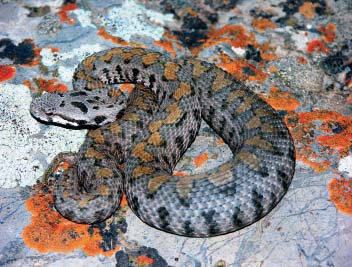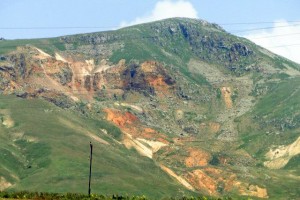Armenian or Radde's viper: Red Data Book of Armenia

Vipers and Pitvipers — Viperidae
Status. An endemic of the Armenian Highland. Listed in the Red Data Book of the former USSR. Listed in the IUCN Red List of Threatened Species (ver. 3.1) as Near Threatened NT. According to IUCN criteria categorized as Vulnerable VU B1a+2b (ii, iii).
Distribution. Eastern part of the South Caucasus and the adjacent areas of Turkey and Iran. In the South Caucasus, the range stretches over the southern branches of the Lesser Caucasus Ridge.
Distribution in Armenia. Isolated sub–populations separated by different barriers exist in the Kotayk, Ararat, Vayots Dzor and Syunik provinces.
Habitats. Inhabits arid forests, juniper sparse forests, mountain grasslands, stony slopes with sparse trees and scrubs at 1300–1800 m, sometimes up to 2500–2700 m above sea level. Occasionally penetrates to arable lands where lives beneath the stones.
Biological traits. Active from early April to late October. Mating begins in mid–May and lasts until late June. The gestation period is 150–160 days. Ovoviviparous. Hatchlings emerge from late August to late September. The reproductive cycle of female Armenian vipers is usually 2 years.
Population size and its trends. Since recent times, the population is sharply decreasing.
Major threats. Deterioration of typical habitats through slope ploughing, construction works, deforestation and overgrazing in grasslands and meadows. Illegal harvesting also poses a serious threat.
Conservation measures. Only small portion of the range is protected in Khosrov Forest Reserve, Shikahogh Reserve and Arevik National Park. The methods of viper maintenance and breeding in captivity are developed and applied. It is essential to establish several sanctuaries in the Abovian district, Kotayk Province and to strengthen control over poaching.
Suggestions
 The Ministry of Environment sent a letter international partners to draw their attention to the real danger of environmental disasters as a result of Azerbaijan's large-scale aggression towards the territory of Armenia
The Ministry of Environment sent a letter international partners to draw their attention to the real danger of environmental disasters as a result of Azerbaijan's large-scale aggression towards the territory of Armenia
 Launch of Amulsar Construction Is End to Little Armenian Switzerland-Jermuk
Launch of Amulsar Construction Is End to Little Armenian Switzerland-Jermuk
 According to Nature Protection Ministry RA, Emissions 'Pure Iron' CJSC and 'Armenian Titanium Production' LLC within Standards
According to Nature Protection Ministry RA, Emissions 'Pure Iron' CJSC and 'Armenian Titanium Production' LLC within Standards
 Vicia pisiformis: Red Data Book of Armenia
Vicia pisiformis: Red Data Book of Armenia
 Vavilovia formosa: Red Data Book of Armenia
Vavilovia formosa: Red Data Book of Armenia












